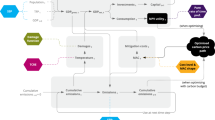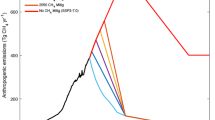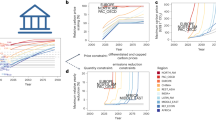Abstract
Most of the integrated assessment modelling literature focuses on cost-effective pathways towards given temperature goals. Conversely, using seven diverse integrated assessment models, we project global energy CO2 emissions trajectories on the basis of near-term mitigation efforts and two assumptions on how these efforts continue post-2030. Despite finding a wide range of emissions by 2050, nearly all the scenarios have median warming of less than 3 °C in 2100. However, the most optimistic scenario is still insufficient to limit global warming to 2 °C. We furthermore highlight key modelling choices inherent to projecting where emissions are headed. First, emissions are more sensitive to the choice of integrated assessment model than to the assumed mitigation effort, highlighting the importance of heterogeneous model intercomparisons. Differences across models reflect diversity in baseline assumptions and impacts of near-term mitigation efforts. Second, the common practice of using economy-wide carbon prices to represent policy exaggerates carbon capture and storage use compared with explicitly modelling policies.
This is a preview of subscription content, access via your institution
Access options
Access Nature and 54 other Nature Portfolio journals
Get Nature+, our best-value online-access subscription
$32.99 / 30 days
cancel any time
Subscribe to this journal
Receive 12 print issues and online access
$209.00 per year
only $17.42 per issue
Buy this article
- Purchase on SpringerLink
- Instant access to full article PDF
Prices may be subject to local taxes which are calculated during checkout




Similar content being viewed by others
Data availability
The datasets40 generated during, and analysed in, the current study are available from a public repository (https://doi.org/10.5281/zenodo.5562199). Source data are provided with this paper.
Code availability
The code for the analysis in this paper is available upon request to the corresponding author. The code availability for the individual models used in this paper varies and contact should be made to individual modelling groups. The GCAM model is available for download from https://github.com/JGCRI/gcam-core. Detailed model documentation for all seven models is available online at https://www.i2am-paris.eu/detailed_model_doc.
Change history
08 December 2021
There were errors in the Fig. 1 Source Data initially presented online. The errors do not affect any conclusions in the paper, and the Source Data have been replaced as of 8 December 2021.
References
The Paris Agreement (UNFCCC, 2020); https://unfccc.int/process-and-meetings/the-paris-agreement/the-paris-agreement
Le Quéré, C. et al. Drivers of declining CO2 emissions in 18 developed economies. Nat. Clim. Change 9, 213–218 (2019).
Roelfsema, M. et al. Taking stock of national climate policies to evaluate implementation of the Paris Agreement. Nat. Commun. 11, 2096 (2020).
Hausfather, Z. & Peters, G. P. Emissions—the ‘business as usual’ story is misleading. Nature 577, 618–620 (2020).
Grant, N., Hawkes, A., Napp, T. & Gambhir, A. The appropriate use of reference scenarios in mitigation analysis. Nat. Clim. Change 10, 605–610 (2020).
IPCC Special Report on Global Warming of 1.5 °C (eds Masson-Delmotte, V. et al.) (WMO, 2018).
IPCC Climate Change 2014: Mitigation of Climate Change (eds Edenhofer, O. et al.) (Cambridge Univ. Press, 2014).
Robinson, J. B. Futures under glass: a recipe for people who hate to predict. Futures 22, 820–842 (1990).
Kriegler, E. et al. Making or breaking climate targets: the AMPERE study on staged accession scenarios for climate policy. Technol. Forecast. Soc. Change 90, 322–326 (2015).
Eskander, S. M. S. U. & Fankhauser, S. Reduction in greenhouse gas emissions from national climate legislation. Nat. Clim. Change 10, 750–756 (2020).
Meckling, J. & Jenner, S. Varieties of market-based policy: instrument choice in climate policy. Environ. Polit. 25, 853–874 (2016).
Bataille, C., Guivarch, C., Hallegatte, S., Rogelj, J. & Waisman, H. Carbon prices across countries. Nat. Clim. Change 8, 648–650 (2018).
Jacoby, H. D., Chen, Y.-H. H. & Flannery, B. P. Informing transparency in the Paris Agreement: the role of economic models. Clim. Policy 17, 873–890 (2017).
Aldy, J. et al. Economic tools to promote transparency and comparability in the Paris Agreement. Nat. Clim. Change 6, 1000–1004 (2016).
Rogelj, J. et al. Understanding the origin of Paris Agreement emission uncertainties. Nat. Commun. 8, 15748 (2017).
Rogelj, J. et al. Paris Agreement climate proposals need a boost to keep warming well below 2 °C. Nature 534, 631–639 (2016).
Geiges, A. et al. Incremental improvements of 2030 targets insufficient to achieve the Paris Agreement goals. Earth Syst. Dyn. 11, 697–708 (2020).
Fawcett, A. A. et al. Can Paris pledges avert severe climate change? Science 350, 1168–1169 (2015).
Fujimori, S. et al. Implication of Paris Agreement in the context of long-term climate mitigation goals. Springerplus 5, 1620 (2016).
Vandyck, T., Keramidas, K., Saveyn, B., Kitous, A. & Vrontisi, Z. A global stocktake of the Paris pledges: implications for energy systems and economy. Glob. Environ. Change 41, 46–63 (2016).
Vrontisi, Z. et al. Enhancing global climate policy ambition towards a 1.5 °C stabilization: a short-term multi-model assessment. Environ. Res. Lett. 13, 044039 (2018).
McCollum, D. L. et al. Energy investment needs for fulfilling the Paris Agreement and achieving the Sustainable Development Goals. Nat. Energy 3, 589–599 (2018).
Jeffery, M. L., Gütschow, J., Rocha, M. R. & Gieseke, R. Measuring success: improving assessments of aggregate greenhouse gas emissions reduction goals. Earths Future 6, 1260–1274 (2018).
Emissions Gap Report 2020 (UNEP, 2020).
Giarola, S. et al. Challenges in the harmonisation of global integrated assessment models: a comprehensive methodology to reduce model response heterogeneity. Sci. Total Environ. 783, 146861 (2021).
Krey, V. et al. Looking under the hood: a comparison of techno-economic assumptions across national and global integrated assessment models. Energy 172, 1254–1267 (2019).
Jaxa-Rozen, M. & Trutnevyte, E. Sources of uncertainty in long-term global scenarios of solar photovoltaic technology. Nat. Clim. Change 11, 266–273 (2021).
den Elzen, M. et al. Are the G20 economies making enough progress to meet their NDC targets? Energy Policy 126, 238–250 (2019).
Dubash, N. K., Khosla, R., Rao, N. D. & Bhardwaj, A. India’s energy and emissions future: an interpretive analysis of model scenarios. Environ. Res. Lett. 13, 074018 (2018).
Schaeffer, R. et al. Comparing transformation pathways across major economies. Climatic Change 162, 1787–1803 (2020).
Harmsen, M. et al. Integrated assessment model diagnostics: key indicators and model evolution. Environ. Res. Lett. 16, 054046 (2021).
Kriegler, E. et al. Diagnostic indicators for integrated assessment models of climate policy. Technol. Forecast. Soc. Change 90, 45–61 (2015).
Keppo, I. et al. Exploring the possibility space: taking stock of the diverse capabilities and gaps in integrated assessment models. Environ. Res. Lett. 16, 053006 (2021).
Hoesly, R. M. et al. Historical (1750–2014) anthropogenic emissions of reactive gases and aerosols from the Community Emissions Data System (CEDS). Geosci. Model Dev. 11, 369–408 (2018).
Nikas, A. et al. Perspective of comprehensive and comprehensible multi-model energy and climate science in Europe. Energy 215, 119153 (2021).
Meinshausen, M. et al. Emulating coupled atmosphere-ocean and carbon cycle models with a simpler model, MAGICC6 – Part 1: Model description and calibration. Atmos. Chem. Phys. 11, 1417–1456 (2011).
Matthews, H. D. et al. Opportunities and challenges in using remaining carbon budgets to guide climate policy. Nat. Geosci. 13, 769–779 (2020).
Peters, G. P. The ‘best available science’ to inform 1.5 °C policy choices. Nat. Clim. Change 6, 646–649 (2016).
Riahi, K. et al. The Shared Socioeconomic Pathways and their energy, land use, and greenhouse gas emissions implications: an overview. Glob. Environ. Change 42, 153–168 (2017).
Sognnaes, I. et al. Sognnaes_et_al_2021_NCC_DATASET version 1.1. Zenodo https://zenodo.org/record/5562199 (2021).
Acknowledgements
I.S., A.A.-K., H.B., L.C., E.D., H.D., A.G., S.G., A.H., A.C.K., A.K., S.M., J.M., A.N., S.P., G.P.P., J.R., D.-J.v.d.V. and M.V. acknowledge support from the H2020 European Commission Project PARIS REINFORCE (grant no. 820846). N.G. was supported by the Natural Environment Research Council (NERC) (grant no. NE/L002515/1) as well as the Department for Business, Energy and Industrial Strategy (BEIS).
Author information
Authors and Affiliations
Contributions
I.S. and G.P.P. coordinated the protocol for scenarios, which were designed by all authors, with notable contributions from L.C., H.D., A.G., S.G., A.C.K., S.M., A.N., S.P., J.R., D.-J.v.d.V. and M.V.; A.G., S.G., S.M., A.N. and D.-J.v.d.V. coordinated the harmonization protocol; all authors were involved in the model analysis, with notable contributions from D.-J.v.d.V., J.M. (GCAM), A.G., A.C.K., N.G., S.M. (TIAM), S.G., A.H. (MUSE), A.K. (FortyTwo), S.P., M.V. (GEMINI), L.C., E.D. (ICES), A.A.-K. and H.B. (E3ME). I.S. and G.P.P. compiled and analysed the results and created the figures, with feedback from all other authors. I.S. coordinated the conception and writing of the paper; all authors provided feedback and contributed to writing the paper.
Corresponding author
Ethics declarations
Competing interests
The authors declare no competing interests.
Additional information
Peer review information Nature Climate Change thanks Jennifer Morris and the other, anonymous, reviewer(s) for their contribution to the peer review of this work.
Publisher’s note Springer Nature remains neutral with regard to jurisdictional claims in published maps and institutional affiliations.
Extended data
Extended Data Fig. 1 Carbon price scenario implementation.
a, Implementation of CP_Price scenarios. First, current policies are explicitly implemented to 2030, and the resulting emissions in 2030 are recorded. Second, models are re-run to reach the same levels of emissions as in the previous step using a carbon price (C1) alone. Third, scenarios are extended post-2030 by growing the carbon price (C1) with GDP per capita. The resulting emissions pathways (P1(t)) are recorded. Fourth, models are re-run with current policies explicitly implemented to 2030, and as constant or minimum bounds on effort post-2030. The emissions pathways achieved in the previous step (P1(t)) are implemented as upper bounds on emissions. b, Implementation of NDC_Price scenarios follows the implementation of CP_Price scenarios, except for the first step. First, current policies are explicitly implemented to 2030. Then, the emissions levels achieved in 2030 in each model region are compared with NDC targets. When additional effort is required to achieve NDC targets, this is implemented on top of current policies. See Supplementary Text 2 for the full scenario protocol.
Supplementary information
Supplementary Information
Supplementary Figs. 1–11, Tables 1–4, Text 1–5 and references.
Supplementary Data
Inventory of current policies used in the analysis.
Source data
Source Data Fig. 1
Data for Fig. 1.
Source Data Fig. 2
Data for Fig. 2.
Source Data Fig. 3
Data for Fig. 3.
Source Data Fig. 4
Data for Fig. 4.
Rights and permissions
About this article
Cite this article
Sognnaes, I., Gambhir, A., van de Ven, DJ. et al. A multi-model analysis of long-term emissions and warming implications of current mitigation efforts. Nat. Clim. Chang. 11, 1055–1062 (2021). https://doi.org/10.1038/s41558-021-01206-3
Received:
Accepted:
Published:
Issue Date:
DOI: https://doi.org/10.1038/s41558-021-01206-3
This article is cited by
-
Optimizing afforestation pathways through economic cost mitigates China’s financial challenge of carbon neutrality
Communications Earth & Environment (2025)
-
Integrated irrigation and nitrogen optimization is a resource-efficient adaptation strategy for US maize and soybean production
Nature Food (2025)
-
Energy and socioeconomic system transformation through a decade of IPCC-assessed scenarios
Nature Climate Change (2025)
-
An in-depth review of key technologies and pathways to carbon neutrality: classification and assessment of decarbonization technologies
Carbon Neutrality (2025)
-
Temperature overshoot responses to ambitious forestation in an Earth System Model
Nature Communications (2024)



